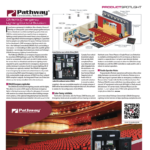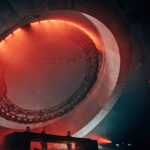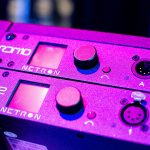I cut my teeth in lighting from early on, but eventually found myself working for a video production company, finding the gear far cooler — and far more complex. Back in those days, lights were lights, projectors were projectors, and never the twain met. But there were some emerging technologies and we always dreamed about marrying them, or at least producing a weird hybrid-freak-son-daughter.
Moving lights were all the rage, but no one had really pushed things as of yet. Video had started to creep into the lighting vernacular, and the word “convergence” was coined — and it stuck to the industry like glue from then on. Lots of things were borne from that term. Media servers, for instance, but then the industry took an entirely different tack — LED.
Now we had instruments that wanted to just replace lamps with LED, we had LED instruments that wanted to be LED walls, we had panels on yokes that were bright enough to actually be instruments….where does this all end?

The VDO Series
With true convergence, of course. The marriage of light and video as instruments of design. Enter the VDO series of hybrid fixtures from Martin. A little background on this emerging trend first:
The VDO Series was introduced with the VDO Sceptron, a long, single strand of LED’s mounted on an extruded aluminum “wand” that can be controlled by Martin’s P3 controller via the Martin P3 Powerport 1500. The line was introduced with a 10mm pixel pitch and then expanded to include 20mm and 40mm pitches in lengths of 320mm and 1000mm respectively. They all are capable of daisy-chaining or modular hook up using proprietary 6-pin cabling that passes video signal and power in an IP65 rated system.
All are capable of accepting different “lenses,” or optical diffusers, that are field interchangeable and require no tools. This allows an extremely wide array of setup configurations. Want a razor square look? Snap on the square diffuser. Want to wash a wall or set piece? There’s a lens for that. Or just simply use them unaltered for true LED strip look, or stack them for a grid matrix look.
There is a wide array of accessory mounts for linking them length-wise or stacking them. There is also a number of mount options — clamps for truss, flat screw plates for wall-mounting or on a set piece, and interconnects for linking the instruments to themselves.
Cabling has long been the Achilles heel of instruments, but the VDO line overcomes this with flying colors. Each module is equipped with a pass-thru style connector that allows for multiple daisy-chain options. The 6-pin cabling allows for signal and power to pass up to 20 meters in the case of the Sceptron 20. But the length from the external power supply to the first fixture is a whopping 50 meters! So this obviously reduces the amount of cabling necessary to power the units as well as making it easy to hide or place a power supply to the source.

The P3 System Controller
All this sounds wonderful and magical, but what about getting content onto them? What about addressing? All this is done through the P3 system controller. It automatically addresses and maps the video content using the P3 controller. There is no need for intermediate cabling or converter boxes. Content can be input to the P3 box and mapped with ease to all the fixtures in the link, and then you can forget about it. This system is also compatible with Martin’s VC line of LED’s.
What if they look inconsistent, like pretty much every LED product out there? Martin utilizes advanced color calibration technology on every single instrument they produce, so you can be assured that your product will be calibrated using the most rigorous techniques.
Brightness is calibrated at 750 lumens/meter for the 10mm product. That’s really bright — when stacking them, they yield 8333 nits. The really cool thing for me is that you don’t even really need to think about any of this when designing or deploying this product. Obviously, you need to think about the pixel pitch, but when you’re lining sets or coming up with flat-field effects, the gloves are off!
The P3 system itself is a standalone, high-performance video processing engine. Simply send the unit your video feed via DVI or Dual SDI ports, and you’re good to map up to 2,000,000 pixels. Link them together or hook them up to a Hippo for more output capabilities, including 16-bit/color. You can also use the P3 system in a simple DMX mode (8 bit) for legacy systems, rendering your instruments in plain old fixture mode, or switch between the two protocols. This makes it really easy to adapt older rental systems (or choose to switch to P3). Think of the level of eye candy you can reach for all the foof lighting in tents and banquet rooms!

“New” News
This is all grand. But they’ve had these out for a year now. What of new news?
The latest addition to the VDO series are the as-yet-to-be-released Dotron and Fatron. The Dotron is a “puck”-like fixture that is 70mm in diameter and uses all the features of the Sceptron family, while the Fatron is basically the Sceptron, only four lanes wide!
Being circular, the Dotron allows for more creative connections between the Sceptron family. With the interconnect accessory clamps, you can attach a Dotron onto a string of Sceptrons and create some truly weird and inspired looks. The Fatron is basically the Sceptron, only wider — 80mm (four rows) wide, to be exact — and the effects are obvious. With the measurement so close to the Dotron’s width, the combinations will be endless and consistent.
Everything about the Sceptron family and the P3 system made me drool. All (or most) of the lighting/video rig can be controlled by an easy-to-use mapping/power supply, simple field-changeable lensing, and easy daisy-chain cabling. Lightweight, bright, and simple. It almost seems like convergence is here and we don’t need to do a thing.
Dotron and Fatron Specs
Fatron
- Length: Available in 320 mm and 1000 mm versions
- Width: 80 mm
- Height: 28 mm (without diffuser/lens installed)
- Weight: 2.5 kg / m (without diffuser/lens installed)
- Color resolution: 16 bits per color (48 bits per pixel)
- Viewing angle: 120° x 120°
- Pixels per meter: 50 x 4
- Pitch (pixel center-to-center): 20.0 mm
- Luminous intensity, calibrated mode: 750 lumens per meter
- Total output, calibrated mode: 6250 nits
- MSRP: Not announced at time of this publication
Dotron
- Diameter: 72 mm
- Height: 34 mm (without diffuser/lens installed)
- Weight: 0.3 kg (without diffuser/lens installed)
- Color resolution: 16 bits per color (48 bits per pixel)
- Luminous intensity, calibrated mode: 40 cd
- Total output, calibrated mode: 4000 nits (with fixtures placed in array at 100mm, center-to-center)
- MSRP: Not announced at time of this publication
Manufacturer: Martin Professional
More Info: www.martin.com


